Vesta Swings past Earth
Vesta Approaches Earth
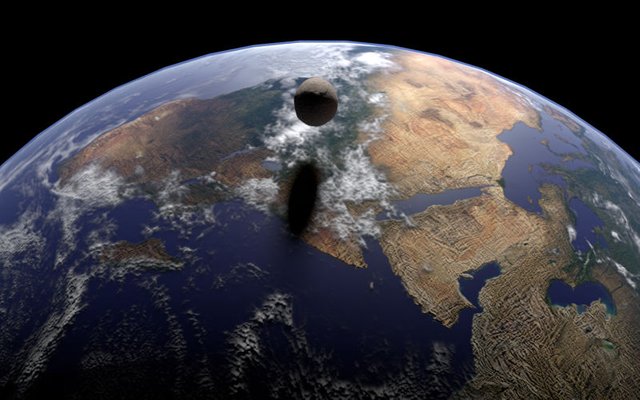
Rendered view (in Blender) showing the comparative size of earth and Vesta. You will notice the African continent and part of Europe in the image. Although Vesta is shown here hovering 500km of the surface of the earth, in reality, it can never get closer than 172 million km from us. 3D data credit: Doug Ellison / NASA-JPL
Vesta, one of the largest asteroids is currently well placed for viewing and in fact if you know exactly where to look and you have access to a dark sky you might even see it with the naked eye. Although technically bright enough to see with the naked eye, binoculars are far better for seeking out the asteroid. Don’t expect to see anything more than a star though, although it’s kind of cool to be able to say you saw a dwarf planet with your own eyes!
During July, it slowly fades but continues to be visible in binoculars, not too far from the planet Saturn in the sky. If you're interested in finding the asteroid, I’ve included the asteroid's path in the photograph below.
Vesta was recently visited by the DAWN spacecraft which showed that it is 525km in diameter and somewhat oblate in shape. Apart from a large number of impact crater’s one of the more distinguishing features is the large trough’s that run approximately around the equator of the asteroid. These troughs are believed to have been caused by crust movement from the huge impact that caused the Rheasilvia crater at the asteroid’s south pole. Vesta is the second most massive asteroid in the asteroid belt (between Mars and Jupiter) but falls short of being called a dwarf planet.
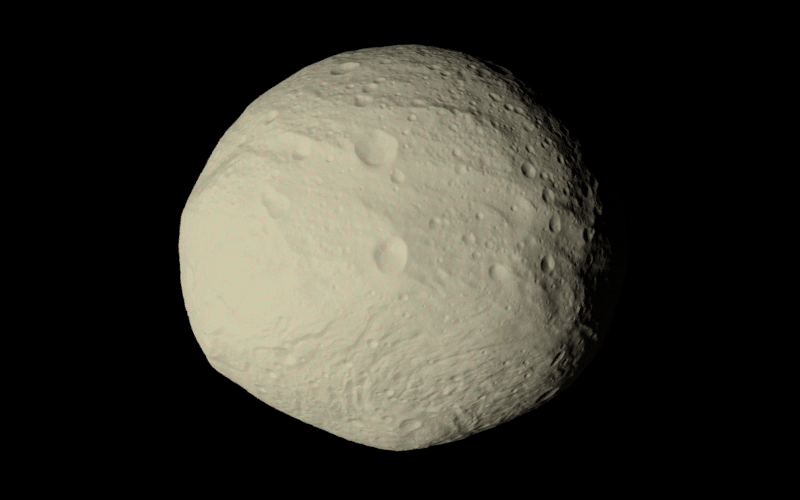
Vesta in 3D. I used 3D data from NASA's DAWN mission to generate this rotational animation in Blender. 3D data credit: Doug Ellison / NASA-JPL
I was also able to easily detect Vesta just using my Olympus camera with its standard kit lens, with no extra equipment (apart from a tripod) just a few days ago. Setting the camera to manual mode, focal length to 14mm (the widest setting), focal ratio f4, exposure to 20 seconds I managed to capture the following shot. So if you don't have any luck finding in binoculars you might just succeed with a camera and wide angle lens. It may even be worth trying with a smartphone with a suitable long exposure app installed.
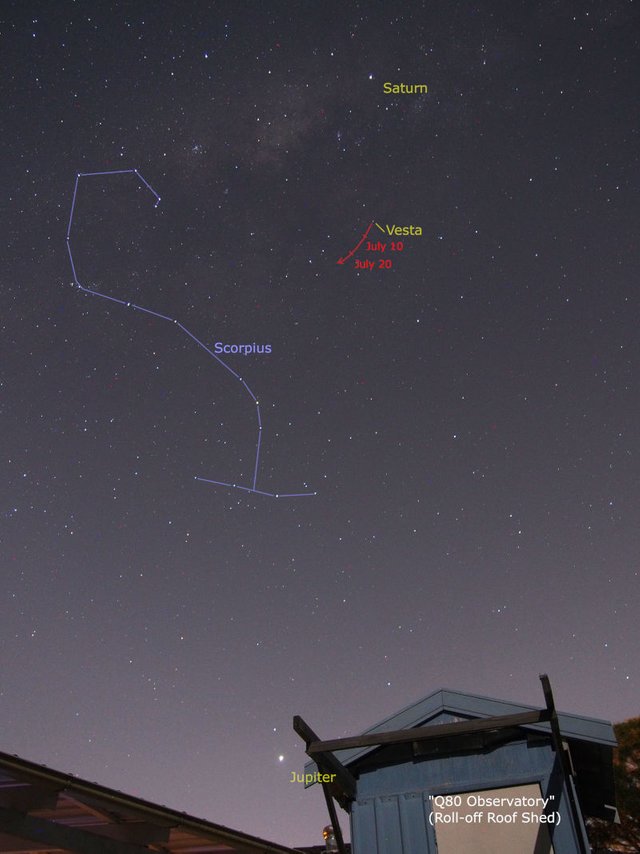
Jupiter, Saturn and Vesta are visible in this simple tripod photo. The constellation of Scorpius is marked and there is also a hint of the milky way visible. Click on image for a non-annotated version. For people wanting to find the asteroid, the red line shows the movement of the asteroid over the next month
Meanwhile Jupiter and Venus on a night of "Good Seeing"

Meanwhile, Jupiter was terrific, and at the time the moon IO was transiting the planet as well as leaving a shadow. The planet looked impressive even in live view on the computer screen. However, the real magic happens when you stack the images and process them through wavelet filters. Here is the result of stacking 8,450 images (!). Not only can you see a lot of cloud detail on the planet itself, but also some detail on the moon IO itself. For comparison, IO is similar to Australia in size.
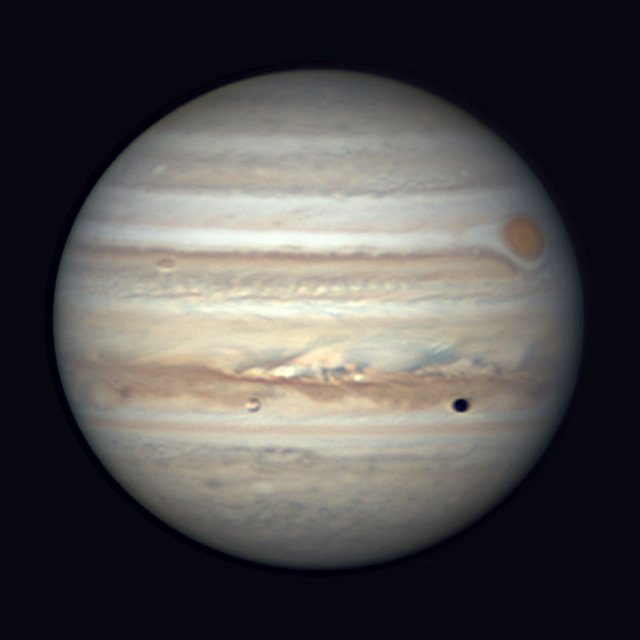
The moon IO transit's the face of Jupiter. It's shadow appears on the right. This image was made using a Celestron C14 operating at a focal length of 7000mm.
Finally...
Things have been busy lately, and my time here on Steemit has been limited, but I hope you all enjoy this brief update on what I've been up to in astronomy. I've also been testing some new cameras recently so hope to post the results soon. I also plan to post some more on comets soon.
NOTE: All images are the authors unless otherwise noted.

SteemSTEM is a community project with the goal to promote and support Science, Technology, Engineering and Mathematics on the Steem blockchain. If you wish to support the steemSTEM project you can:
Contribute STEM content using the #steemstem tag | Support steemstem authors | Join our curation trail | Visit our Discord community | Delegate SP to steemstem
This post has been voted on by the steemstem curation team and voting trail.
There is more to SteemSTEM than just writing posts, check here for some more tips on being a community member. You can also join our discord here to get to know the rest of the community!
Hi Terry,
nice to see/read that you are back. Great read 😊
When the clouds here are moving away and when I’m able to could see Vesta on the northern hemisphere, I will give it a try to take picture.
Which cameras you will testing?
Thanks Kevin, the QHY183c and QHY183m, and maybe some comparisons with other cameras.
Looks like it has almost, but not quite, reached hydrodynamic equilibrium (collapsed into a sphere). Close but no cigar.
It would be cool to go there, set up a very large inflatable tent on the surface and mine gold in your shirt sleeves.
The gravity is something like 0.25 m/s^2 (~2.5% of Earth) so hopping around would be a lot of fun for a while. Picking up large boulders in your hands and moving them around like nothing would make for a great YouTube video.
https://en.wikipedia.org/wiki/4_Vesta
4 Vesta
Vesta, minor-planet designation 4 Vesta, is one of the largest objects in the asteroid belt, with a mean diameter of 525 kilometres (326 mi). It was discovered by the German astronomer Heinrich Wilhelm Olbers on 29 March 1807 and is named after Vesta, the virgin goddess of home and hearth from Roman mythology.
Vesta is the second-most-massive and second-largest body in the asteroid belt after the dwarf planet Ceres, and it contributes an estimated 9% of the mass of the asteroid belt.
It is slightly larger than Pallas, though significantly more massive.
Yeh it kind of almost a sphere and appears to have a differentiated interior which suggests it almost makes the grade.
My favorite picture was the last one, with Jupiter and one of its moon casting a shadow.
Cheers @terrylovejoy!
Glad you enjoyed it here is a 2 frame animated gif I made from 2 sets of images made the same night but about 30 minutes apart.
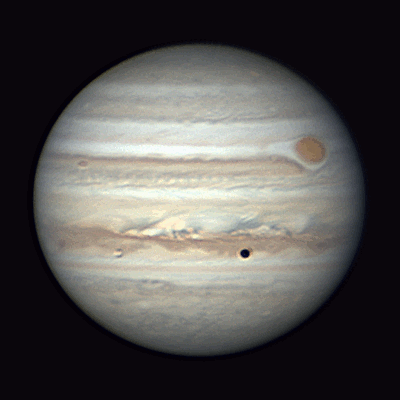
Hello @terrylovejoy
I must commend your scientific engagement by trying to have a real life view objects in the milky way! And encouraging us to do same! What's the implications of jesta being close to earth? Is it gonna fall on us😱?
Regards
@eurogee of @euronation and @steemstem communities
Thank you @eurogee. No chance of it falling on us, ever :) - check out first image caption.
upvote for me please? https://steemit.com/news/@bible.com/2sysip
Hi @terrylovejoy!
Your post was upvoted by utopian.io in cooperation with steemstem - supporting knowledge, innovation and technological advancement on the Steem Blockchain.
Contribute to Open Source with utopian.io
Learn how to contribute on our website and join the new open source economy.
Want to chat? Join the Utopian Community on Discord https://discord.gg/h52nFrV
Fascinating information that i never new about.